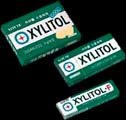On a food label you might find xylitol classified as a carbohydrate but it is actually a natural sugar alcohol known more specifically as a polyalcohol (polyol). If you want to get even more in depth on the chemical profile of xylitol you would say that it is of the pentitol type of sugar alcohols meaning it has five carbon atoms and five hydroxyl groups. The number of carbon atoms becomes important when considering the dental benefits of xylitol which I will divulge more on later.
Strictly speaking, polyols are not actually sugars but can, with legitimacy, be considered within the "sugar field" because of certain biochemical relationships. Polyols, for example, are commonly formed from sugars and can as well be converted into sugars such as aldoses (a class of monosaccharide sugars contain that an aldehyde group) and ketoses (various carbohydrates that contain a ketone group).
Xylitol has actually been in use since the 60's but no one seems to have heard of it. What's worse is that its potential as a healthy bulk sweetener has been generally overlooked as a result of the lack of awareness. Here in the U.S., xylitol has been approved for use in unlimited quantities in foods used for special dietary purposes. For now it is mostly found in various candies and chewing gums but the list of possibilities for use is quite long.
About the flavor: Xylitol tastes like sugar with near equivalent sweetness and zero after-taste. That's quite the bonus within the realm of the diet flavor associated with aspartame. Dissolving quickly in the mouth, solid xylitol produces what is referred to as a "noticeable" cooling sensation as it melts. Along with the cooling it also has a water-binding property which provides a little "sharpness" or spicy flavor that provokes salivation. Hmm, doesn't exactly sound like sugar anymore, does it?
Where Does It Come From?
 So, Xylitol is natural but where is it found? Well, one place you could look is right inside your body which can produce up to 15 grams of xylitol from other food sources. We are talking about something that is part of everyday metabolism. It is also quite widely distributed throughout nature with some of the best sources being berries, mushrooms, and lettuce.
So, Xylitol is natural but where is it found? Well, one place you could look is right inside your body which can produce up to 15 grams of xylitol from other food sources. We are talking about something that is part of everyday metabolism. It is also quite widely distributed throughout nature with some of the best sources being berries, mushrooms, and lettuce.
The only problem is the still low amounts in the foods with even the highest concentrations. For example: one cup of raspberries contains less than one gram of xylitol.
Since there are no concentrated sources that xylitol can be simply extracted from, it is commercially produced through the hydrogenation of xylose, also known as wood sugar, which is derived from the xylan hemicellulose polymer found in hardwoods, nut shells, etc. Although xylitol can be made through laboratory synthesis or microbial production, these methods have proven to be too expensive. Instead, the xylan from which xylitol can be made is obtained from birch tree scraps. That's right, scraps. It can be considered recycled food.
The whole process is quite energy intensive and large scale. Because of this, Xylitol is one the more expensive sweeteners and is likely to stay high on the price chart since it is in high demand. For perspective consider that xylitol is at least ten times more pricey than sucrose. The good part is that is doesn't take much to reap the benefits of xylitol. Heck, you could argue that it will eventually pay for itself by keeping teeth healthy thus eliminating (or at least reducing) the need for fillings and the consequential dentist's bill.
How Does Xylitol Help Teeth, Anyway?
Remember how I said that the number of carbon atoms is important in saving your teeth? Essentially, xylitol is beneficial for teeth because unlike other carbohydrates which are six carbon "hexose" units, xylitol is a five carbon or pentitol sugar alcohol. Since xylitol is held up by a "pentose" backbone bacteria cannot utilize it, plaque cannot ferment it, and ultimately less acid is produced. Xylitol use will generally aid in the decrease of harmful bacteria, yeast, plaque, plaque acids, insoluble extracellular polysaccharides, lipoteichoic acids, and the enzymes that process sucrose. Overall, this makes for a healthier mouth and better breath.
The most tooth damaging acid, lactic acid, is formed in favor through the fermentation of sugars by oral bacteria. Lactic acid contributes to a drop in pH and is able to chelate with calcium and dissolve it. Bacteria cannot ferment polyols which means with the use of xylitol, which has a beneficially high hydrogen to carbon ratio, no damaging lactic acid is produced. Basically, xylitol interferes with every destructive element and will help to push the balance in favor of dental protective factors.
It doesn't just stand by and watch but is instead quite active in promoting dental health by being non-acidogenic, anti-cariogenic, cariostatic, and by harboring the ability to enhance remineralization. Xylitol can also be used in place of fluoride for those who don't trust municipal tap water (like myself). For those who like their fluoride treatments, xylitol and fluoride work very well together.
So mow much do you need to use in order to promote dental health? Studies show that used xylitol occasionally will petty much do nothing regardless of how much you take. The best results are found in taking four to twelve grams per day split into about five separate doses. This is rather easy to do if you're a gum chewer. Just go out and get some of that xylitol gum (or mints) and pop one every couple of hours.
Xylitol Is For Athletes!
I'll start by noting that xylitol has been used as an energy source during posttraumatic stress. When glucose is poorly utilized, xylitol aids in the improvement of the overall metabolic condition. It inhibits muscle wasting by exerting a strong anticatabolic effect as well as improves fat utilization and helps to stabilize insulin levels and blood sugar. For dieters xylitol can fit into many weight-control regimens. It slows stomach emptying which increases satiety and reduces overall food intake. Remember also that xylitol is not completely absorbed thus yielding forty percent fewer calories than sugar.
 Anyone out there who has guzzled down a big glass of Sugar-Tech would do well to chew some xylitol gum afterwards as it will help protect your teeth. Xylitol can work well as a very slow and long lasting energy source when mixed with the faster acting carbohydrates that will help to keep secondary energy and glycogen-generating, protein-building pathways open. Unabsorbed xylitol will act as fiber in the gut where partial bacterial fermentation will produce volatile short-chain fatty acids.
Anyone out there who has guzzled down a big glass of Sugar-Tech would do well to chew some xylitol gum afterwards as it will help protect your teeth. Xylitol can work well as a very slow and long lasting energy source when mixed with the faster acting carbohydrates that will help to keep secondary energy and glycogen-generating, protein-building pathways open. Unabsorbed xylitol will act as fiber in the gut where partial bacterial fermentation will produce volatile short-chain fatty acids.
These fatty acids are utilized along existing insulin-independent energy pathways. Xylitol metabolism activates the glutathione antioxidant system which will get rid of free radicals and reduce oxidative damage to muscle and blood cells. This happens because red blood cells take up xylitol rapidly. Within the red blood cells is the necessary dehydrogenase enzyme which will convert xylitol into L-xylulose as part of the gluconurate cycle. As this goes on, NADPH is generated which is necessary to keep glutathione active. What's more, xylitol can compensate for G-6-PD deficiency in individuals who have it by entering the cycle at a later step. G-6-PD is the enzyme that opens the pentose shunt to boost NADPH production.
For those looking to increase anabolism and decrease catabolism xylitol may be one more thing to add to the list of helpful substances. Xylitol has been shown to increase ATP, to increase fat release and utilization, to replenish glycogen, to be anabolic, anticatabolic, antioxidant, and it helps fight muscle fatigue.
